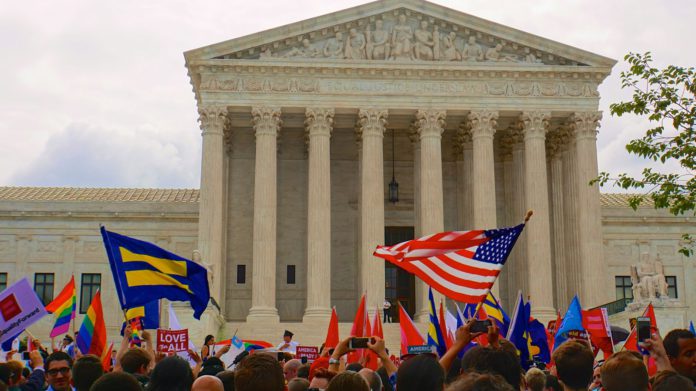
Obergefell v. Hodges in 2015 guaranteed equal rights for same-sex couples to get married, but can treating same-sex couples exactly equal in the context of common law marriage actually have a discriminatory effect? A party in a Colorado case argues yes, and the Colorado Supreme Court has agreed to decide how to analyze whether a same-sex couple has a common law marriage.
The Supreme Court on Sept. 30 granted a petition to hear In re the Marriage of Edi Hogsett and Marcia Neale. In their case, the Arapahoe County District Court used an established test to decide the couple did not have a common law marriage. The Court of Appeals affirmed the decision and noted the district court’s conclusion assumes the U.S. Supreme Court’s Obergefell decision can apply retroactively to find a same-sex common law marriage. Now, Hogsett has appealed the decision finding she did not have a common law marriage with Neale.
Partners’ intent is key when courts look at their relationship to see if they have a common law marriage. The existing test for establishing a common law marriage, known as the Lucero test, looks at mutual agreement to be husband and wife and the couple’s mutual open assertion of their marital relationship. The relationship has to meet both elements for a common law marriage to exist.
But Griffiths Law senior counsel Ann Gushurst, who represents Edi Hogsett, said the Lucero test discriminates against same-sex couples. She said especially in a pre-Obergefell time, a same-sex couple openly declaring they consider themselves married had a political element. Gushurst said courts should instead look at actions that are particular to committed couples but don’t have the political implications of a same-sex couple publicly asserting their relationship, such as owning property together and having children.
“Pick the things that distinguish [a marital relationship] that aren’t heteronormative,” she said.
For Hogsett, the case presents a Catch-22: Applying the same test to same-sex and straight couples is inherently discriminatory since they were not all legally able to do the same things.
Neale and Hogsett began a relationship in 2001 and eventually did joint financial planning, joined their accounts and built a home. They also exchanged rings in an impromptu ceremony. When they decided to separate in 2014, they created a separation agreement to divide their property and for Neale to pay maintenance to Hogsett.
Hogsett believes she and Neale had a common law marriage, but Neale claims they did not. She testified she signed the dissolution petition and separation agreement because she believed she needed to in order to legally divide her and Hogsett’s finances. Neale also testified she does not believe in marriage.
In finding the ex-couple did not have a common law marriage, the district court also relied on evidence that both Neale and Hogsett asked to dismiss their dissolution petition when a family court facilitator told them a court would first need to find they had a common law marriage before moving forward with the petition. The court said, under the Lucero test, if one partner does not believe they are married and the other does, a common law marriage can’t be established.
The Colorado Supreme Court has previously identified some indicators of intent to be married, including living together, having joint financial accounts, owning property together, using the same last name and filing joint tax returns. But the district court acknowledged same-sex couples couldn’t do some of those things before the Obergefell decision, such as listing each other as spouses on financial or medical documents or filing joint tax returns and noted that couples often didn’t use the same last name.
Plog & Stein co-founder Stephen Plog, who represents Neale, said he believes broadening the criteria for a common-law marriage could create the obligations for partners that come with a common-law marriage even if they did not intend to consider themselves married, an unintended consequence he said would impact opposite-sex couples as well. Plog added having different standards for same-sex couples than for opposite-sex couples could open the door to equal protection arguments.
“I think it has the potential to open up many doors and could ultimately lead who knows where,” he said. “Really in my mind what it boils down to is, was the intent there that these people were married or not?”
Sherman & Howard member Jordan Fox explained the conundrum the case presents: Finding a common law marriage between a same-sex couple that had been together since before the Obergefell decision necessitates looking for evidence of intent to have a relationship that wasn’t legally recognized before Obergefell.
The Supreme Court did not grant cert on whether Obergefell applies retroactively, and Fox said he thinks the court will likely assume that it does. It’s an important consideration, he added, because applying the decision retroactively implies that the actions taken by a same-sex couple before Obergefell could end up binding them financially if a court finds they had a common law marriage. It goes back to the requirement in Lucero of intent by the couple to be considered married, Fox said.
“If you knew it was illegal to be married, how could you have had the intent?”
—Julia Cardi

